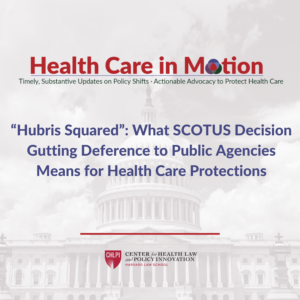Originally posted on Bloomberg Law on February 17, 2021 and written by Christopher Brown
The Trump administration’s eleventh-hour attempt to preserve Medicaid work requirements and circumvent President Joe Biden’s plan to rescind them hinges on the question of whether the effort amounted to guidance or binding contracts, legal analysts say.
At issue are letters former Centers for Medicare & Medicaid Services Administrator Seema Verma sent to states in January to keep Medicaid waivers in effect for nine months after any government movement to rescind them. Verma’s move is seen as an attempt to keep the work requirements alive until the Supreme Court can rule on their validity in a case it will hear in March. Some of these waivers allow states to require recipients of the low-income health program to work as a condition of coverage.
Acting CMS Administrator Elizabeth Richter on Friday notified those states that the Verma letters are rescinded, citing the current administration’s need for flexibility in responding to the Covid-19 pandemic and its need to maintain oversight in the Medicaid waiver program.
Democrats and low-income advocacy groups say work requirements reduce poor adults’ chances of getting health coverage. Biden’s Jan. 28 executive order directed the Department of Health and Human Services to review any Trump administration actions that “may reduce coverage under or otherwise undermine Medicaid,” including demonstration and waiver policies. Richter’s letter is the first step in that process.
Any attempt by the Biden administration to rescind the waivers could open the door to litigation, particularly if the letters from Verma are considered contracts that are binding on the HHS, rather than guidance it is free to rescind.
The Supreme Court also would be less likely to dismiss its review of the issue—which the Biden administration is expected to request—if there’s an unanswered legal question about whether Verma’s letters can be rescinded, said Thomas Barker, a partner at Foley Hoag LLP in Washington who served as general counsel to the HHS under President George W. Bush.
Twelve states have received approval from the CMS to impose work requirements in their Medicaid programs, and at least five of those states signed the Jan. 4 letters: Arizona, Georgia, Ohio, South Carolina, and Utah.
No work requirements are actually in effect. Federal courts have halted Medicaid work requirements in Arkansas, Kentucky, New Hampshire, and Michigan, saying they don’t further the purpose of the health program—which is to provide coverage.
The high court is slated to hear arguments March 29 over the validity of work requirements in Arkansas and New Hampshire.
At Least Nine Months
The CMS’s rescission of the Verma letter, if it holds up, makes it easier for the agency to take the next step and walk back the work requirement waivers. But it would still be a bold move. It’s “unusual” for a new CMS “to come in and rescind the prior administration’s approvals,” Patricia Boozang, senior managing director of Manatt Health, said.
But Biden’s January executive order “signals that this administration has a different set of policy priorities and really wants to look at prior administration policies that may be presenting barriers to people getting coverage, including Medicaid coverage,” she said.
Standing in the way of that strategy are the Jan. 4 letters, which, if deemed legally valid, could keep the waivers alive until the court rules.
“A [Medicaid] waiver is in many respects just a contract between the federal government and a state,” Barker said. “I suppose you could say that this letter is a contract, and if some states have agreed to it, it’s binding.”
The CMS committed itself in the letters to let the waivers remain for at least nine months after the agency has made a determination that they don’t meet the original purpose of Medicaid. The letters also set forth a hearing and briefing schedule for states that wish to contest a CMS decision to rescind a waiver.
That schedule could give states as long as 19 months of protection for their work requirement plans, according to the National Health Law Program, which filed an administrative challenge asking the HHS to withdraw the letters.
Rep. Frank Pallone (D-N.J.), chairman of the House Energy and Commerce Committee, and Sen. Ron Wyden (D-Ore.), chairman of the Senate Finance Committee, also asked the HHS in January to rescind the letters.
Contract or Guidance
Verma said in the letters that the new procedures are intended to fill in the details of an administrative process that is only laid out in the waivers themselves at “a high level.” But the NHLP says the letters violate the Administrative Procedures Act and create obligations that go beyond—and conflict with—existing regulations.
NHLP also contends that the letters are “guidance” and should be withdrawn because they weren’t exposed to public notice and comment. A rule finalized by the HHS in early December says guidance documents can’t impose new binding requirements, and that “significant” guidance documents must go through a notice-and-comment period.
The letters could keep Medicaid work requirements alive long enough for the Supreme Court to rule, even if they are ultimately found to be without legal force, Barker said.
The Supreme Court will decide whether the D.C. Circuit was right to reject work requirements in Arkansas—a ruling that also applied to New Hampshire’s work requirements. Lower courts found that the HHS failed to consider the impact of work rules on the core objective of the Medicaid program—providing insurance to low income people.
But the high court is likely to view the Verma letters skeptically, according to Phil Waters, a staff attorney at the Center for Health Law and Policy Innovation at Harvard Law School.
“It would be hard for the court to look at these letters and say, ‘Even though there have been two courts that have ruled against you, now you have this letter that was written as the previous administration was on the way out, so you can preserve your waiver,’” he said. “I really don’t think that’s going to hold water.”


Health Law & Policy, Commentary
Braidwood Management v. Becerra: Updated FAQs for Health Advocates and Providers
July 22, 2024